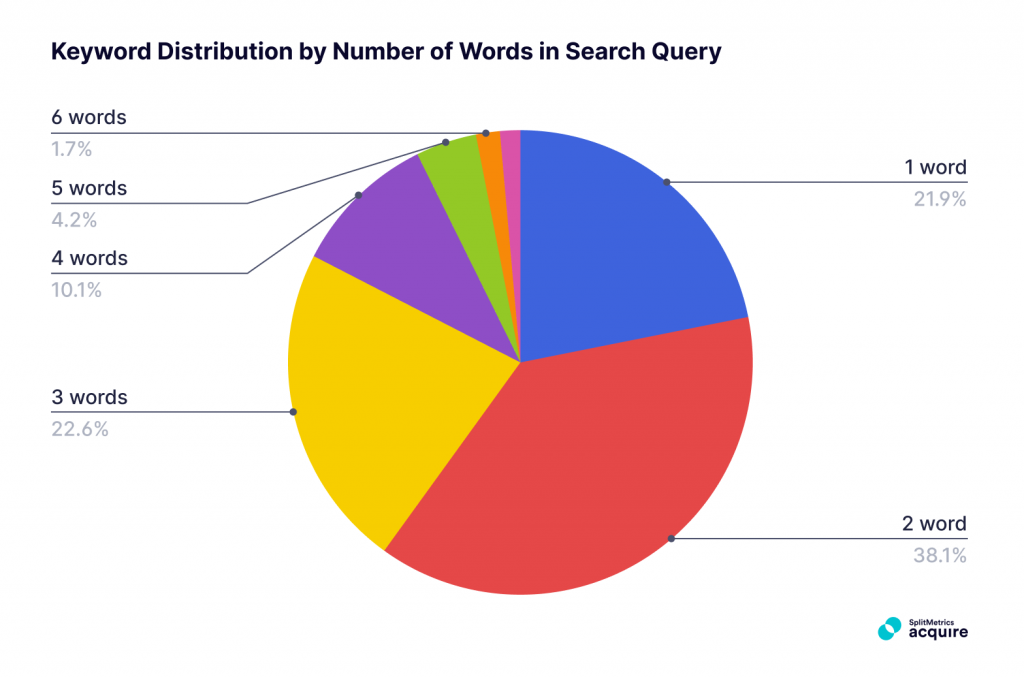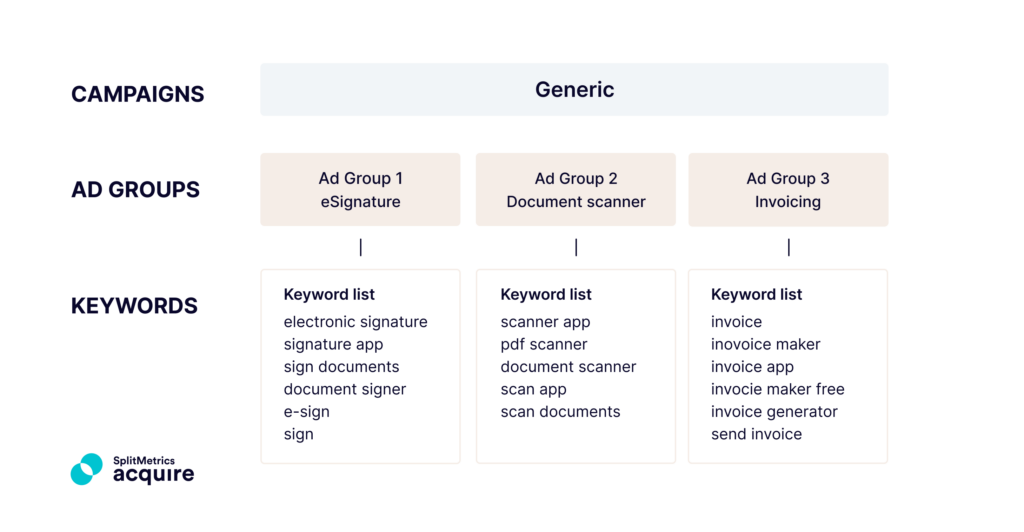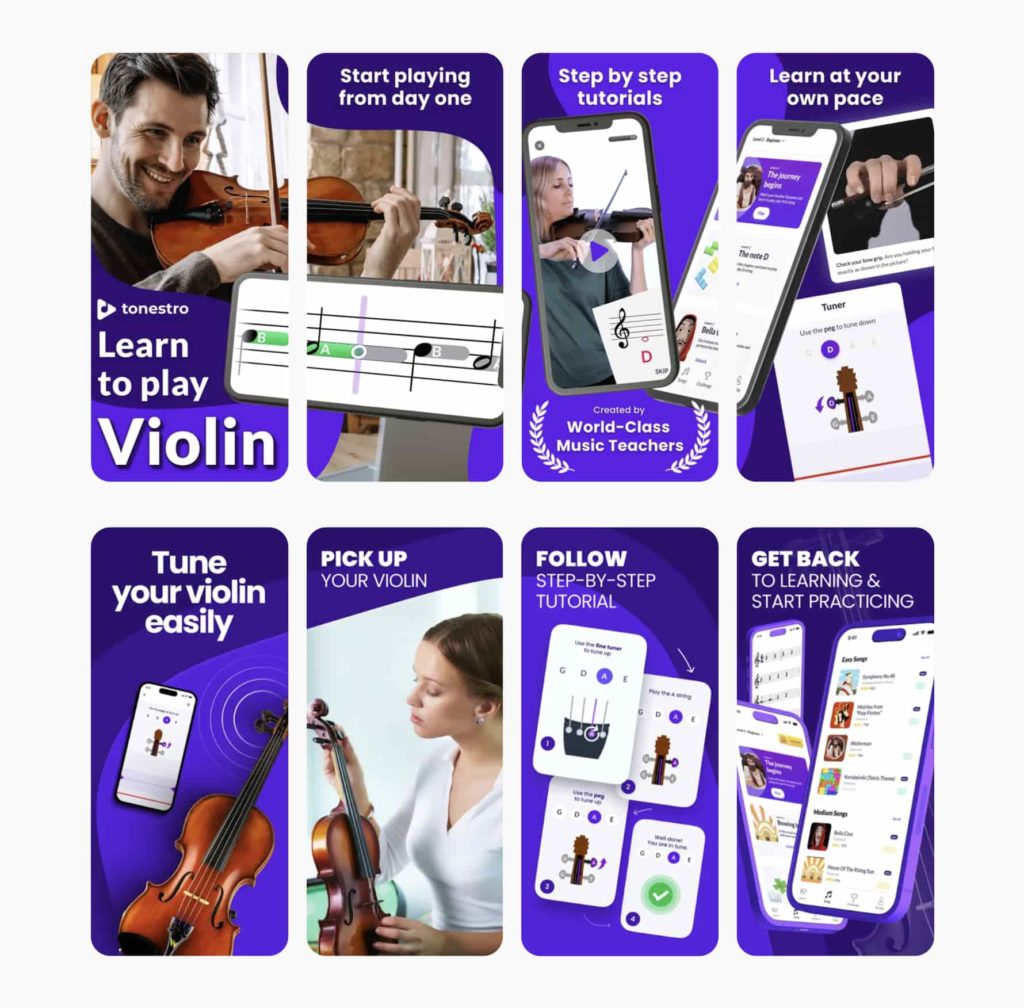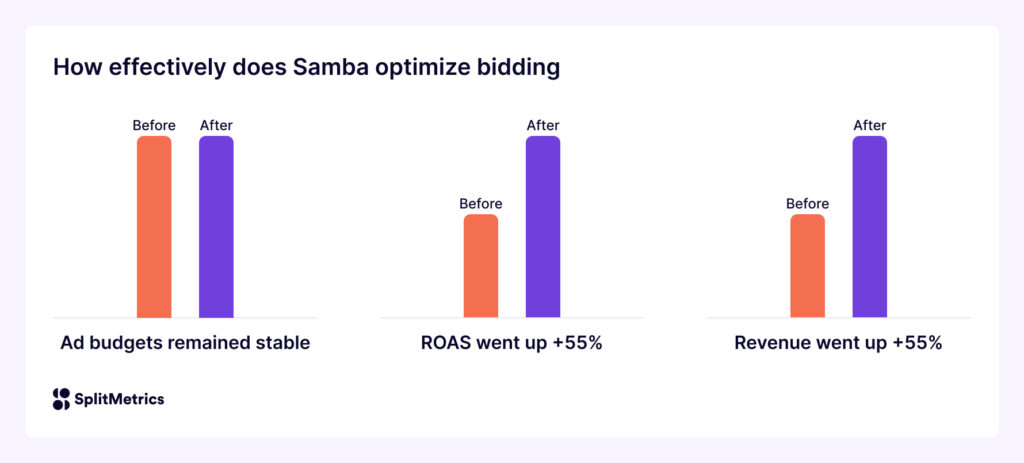How to Run Profitable Apple Ads Category Campaigns
 Gabriel Kuriata
Gabriel Kuriata Category campaigns with Apple Ads search results ads include keywords related to the app’s functionality, themes, mechanics, or other essential characteristics. Their primary goal is to enable app discovery by reaching users who are not yet aware of your brand and incentivizing them to download it.
By definition, category campaigns are a foundation of any Apple Ads strategy, as 70% of App Store visitors use search to discover apps.
In practice, they are the most sprawling, sometimes covering hundreds, if not thousands, of keywords per market, trying to connect with users through as many relevant search queries as possible.
With advertisers striving to reach the broadest possible audience through a multitude of keyword clusters of varying popularity and relevance, category campaigns have their own considerations.
They require continuous research and expansion to keep up with the ever-evolving search patterns and user journeys on the App Store. Their diversity warrants meticulous, granular optimization for best results and prioritizes choosing the proper structure.
Luckily, there’s land on the horizon. Artificial intelligence (AI) can provide granular optimization at scale, optimal for this campaign type. It can also help us understand what our users are looking for or what our competitors are doing.
If you want to understand the basics of campaign management, refer to our article on building a semantics-based structure, which explains the technical aspects of managing all types of campaigns (including brand, competitor, and discovery campaigns), ensuring proper keyword flow, etc.
In this article, we’ll examine how to optimize the performance of category campaigns in Apple Ads and see how the most recent developments in AI can help us take them to the next level.
The key to optimizing category campaigns lies in understanding category keywords. Frequently referred to as generic, these keywords are typically the most diverse and the largest pool for any app. First, let’s dissect the basics by comparing them to the other two, brand campaigns and competitor ones:
| Feature | Brand campaign (Brand keywords) | Category campaign (Category keywords) | Competitor campaign (Competitor keywords) |
| User Intent | Highest. The user is explicitly searching for your app. | Varied. The user is searching for a solution. | Moderate-High. The user is searching for a rival app. |
| Primary Goal | Brand defense, acquisition of high-LTV users. | Discovery. Find new users not yet aware of your app. | Brand offense. Divert traffic from competitors to your app. |
| Conversion Rate (CR) | Highest. Typically low CPT, leading to good CPA. | Varied. Significantly depends on relevance. | Relatively low. However, it may reach valuable users. |
| Bidding Strategy | Dynamic, necessary to reach a significant Impression Share (90%+). | Priority 2 Scale the best keywords & expand the scope of campaigns. | Dynamic/opportunistic. Only in cases of positive post-install metrics. |
| Suggested destination | Default product page, highlighting key features of your app. | Thematic custom product pages for increased relevance | Differentiating custom product pages, to stand out from competitors |
| Budget | Priority 1 Maintain share of voice and maximize installs. | Priority 2 Scale the best keywords & expand campaigns’ scope. | Priority 3 Allocate only to high-performing ones. |
Category keywords are highly varied in terms of search popularity, relevance, and competition level, which in turn impact bidding strategies applicable to them, as they cover any search terms from simple and (logically) popular “free photo editor”, to more specialized but highly relevant “photo filters and effects”.

Even less relevant ones can be profitable with the right management, as they may lead users to our app. Consider this example of keyword clusters for an e-signature app:
| Ad Group | eSignature | Document scanner | Invoicing |
| Intent level | High | Medium | Low |
| Intent | Users looking for your app’s exact functionality. | Users in search of a document scanner app (related feature) | Users searching for invoicing apps (certain connection) |
| Exact keywords | docusigndocusign upload sign docspandadocsignnow | scanner apppdf scannerdocument scannerscan appscan documents | invoice 2goinvoice simpletiny invoicefreshbooks |
Category campaigns connect with users through keywords of varying popularitywith the slection depending on the app category, our budget, features, competitors, time of the year, significant external market trends, events, or even the target market itself.
Before we delve into best practices for category campaigns, let’s lay out the critical facts about category keywords that influence Apple Ads strategy, as well as the structuring and optimization of category campaigns.
Categories like Gaming, Finance, and E-commerce face intense competition for some generic, highly popular keywords (“free game,” “stock market app,” “online shopping”), which significantly drives the average cost per tap (CPT) for them, though they still offer opportunity in the longer tail.
In some categories, such as Games, Utilities, or certain B2B apps, the volume of valuable generic searches is large, making generic campaigns central to the entire acquisition strategy. Conversely, in heavily brand-dominated categories, like Entertainment or Social Networking, the generic volume might be less efficient.
However, these differences go deeper than the category. They should be considered at the subcategory level, as search patterns and user journeys may vary by game genre or finance app type (with cryptocurrency investment apps attracting different types of customers than those seeking to manage their personal wallets).
User journeys are different in each app category and subcategory of apps, impacting search patterns of users and overall app discovery.
Each app’s category keyword pool will contain a large number of less popular keywords, as well as highly popular and strategic ones. Depending on your budget, you might be able to capture a meaningful share of voice in those frequently sought by users. Overall, the art of managing category keywords involves carefully organizing and optimizing them based on their search popularity, relevance, or competition level, to ensure overall profitability at the campaign level.
Understanding keyword relevance and prioritizing user experience is key. Some short, popular keywords may not be suitable for our app, while long-tail keywords, though less frequently searched, can be highly relevant due to their specialization.
All category keyword types can have value and impact your campaign’s profitability. Don’t focus only on the most popular ones.
A direct translation of keywords may not be as effective as a more localized, data-driven approach. Users in different markets can describe app functionalities differently. For example, an app focused on budgeting might target “personal finance tracker” in the US but “money management app” or “savings calculator” in Germany or France, reflecting local banking habits.
Highlighting different themes and features may be critical to conversion rates, warranting not only careful research and keyword selection but also a more personalized messaging approach.
For best results, research each market or region individually to understand what terms are popular in them. They may be considerably different from your home turf.
Category-related searches follow predictable patterns, driven by seasons, festive periods, holidays, or significant events. Fitness terms surge in January, Travel/Booking terms peak in spring/summer. Educational apps enjoy more interest in August and September (the “back-to-school” period).
Remember that each market or region has its unique seasonal trends and events. For example, “New Life” season is an important moment in Japan. Australia has opposite seasons, which means that winter promotions take place during the northern hemisphere’s summer months.
Popular holidays also have their fair share of keywords, as App Store users are looking for Christmas offers, New Year sales, etc. Important sporting events (Olympics, World Cup) can introduce short-term, high-volume generic keywords (e.g., “football score tracker”).
Seasonality should encourage you to treat keyword research and expansion as a continuous, cyclical process. It also shows how vital the right campaign structure is, as it may need to accommodate new or seasonal keywords.

There are multiple ways that the external market has an impact on user behavior and search patterns on the App Store:
External events can impact user journeys and app discovery on the App Store very quickly. Review the market and competitive landscape cyclically to stay ahead of change.
A high-volume generic term can hide a fundamentally different user intent. Bidding on these keywords can result in a high cost per tap (CPT) and a low conversion rate (CR), depleting the budget without any return. Let’s examine the following examples:
| App | Keyword | Actual intent |
| Premium Photo Editing App | remove background | User is looking for a quick, one-off utility tool (which is a feature the app, but not the core intent of the user’s search). The user’s intent is simple utility, not a full editing suite. |
| City-building strategy game | strategy game | A significant percentage of searches may be to find a tactical war game |
| Outfit planner with AI capabilities | fashion | A significant percentage of searches may be intended to find dress-up games |
Category keywords require both semantic and logical analysis, with seemingly relevant ones being possibly mismatched, due to the high popularity of other types of apps being aligned with them.
Category keywords as a whole are highly varied on the category, subcategory, and individual app level. They’re also highly dynamic, subject to seasonality and market trends. Making them profitable in Apple Ads is easier than it seems, though, as their key characteristics simply call for a well-planned and structured approach to optimization. Here are the key principles.
Category campaigns benefit significantly from granular optimization but require it to be done at scale, with advertisers needing to analyze hundreds, if not thousands, of keywords.
Most of the practices described below contribute to this primary goal, starting with the right organization to ensure optimal connection with custom product pages.
A well-planned Apple Ads campaign structure that fits our app’s business model, needs, and audience is the key to success with category campaigns.
It will give us enough flexibility to incorporate varying bidding strategies for selected keyword groups, based on their level of intent, themes, relevance, and profitability. It will easily allow us to accommodate seasonal keywords.

Most importantly, the proper campaign structure will enable more granular optimization at scale. There are multiple approaches to structuring our category campaigns in Apple Ads. All of these are described in our guide to creating a semantics-based campaign structure for Apple Ads, which considers all the variables of generic keywords we’ve discussed earlier.
Search popularity, relevance, and competition level are three crucial Apple Ads keyword metrics, showing how frequently App Store users search for them, how effective they can be for your app in terms of incentivizing users to tap on your ads and later download your app, as well as how active your competitors are for it.
Keyword relevance should be your priority. Focusing on search popularity can lead to misidentification of actual user intent. Even the best keywords are not worth advertising on in search results if the level of competition makes return on investment negligible, or even worse, below zero.
Balancing these three metrics is much easier when done on a well-functioning campaign structure, as segmentation of keywords by themes or profitability can lead to more effective bidding and budget management.
Seasonality, market trends, new apps, and technologies make the global category keyword pool highly dynamic. The incredible diversity of App Store users, with millions searching for new apps daily, creates numerous opportunities that can be discovered if we have the right tools at hand.
Use negative keywords to optimize relevance: Negative keywords are an important setting in Apple Ads, aimed at optimizing the overall relevance and conversion rates of your campaigns. Eliminating keywords that might lead to ads being mismatched with the actual intent behind a search may have a very positive impact on your overall performance.
Full semantic comparative analysis with competitors, using our Keyword Gap feature, or structured, AI-driven keyword research will help achieve a breakthrough and find growth opportunities, even in categories with seemingly less robust search patterns.
Apple Ads discovery campaigns play a key role in category campaigns. First, they provide a continuous inflow of new keywords (with the best-performing ones being added as exact-match keywords to them). Automated with the Search Match feature, they react immediately to the evolving market situation.
Additionally, discovery campaigns allow targeting of less popular, but highly relevant search terms. As mentioned above, some specialized search terms can carry significant download intent.
The discovery campaign is an essential tool for capitalizing on seasonality on the App Store, enabling you to detect when relevant search terms start gaining traction.
Custom product pages are alternate versions of an app’s default listing on the App Store, tailored to target a particular audience and address its unique needs by highlighting specific features and themes.
Following a significant update announced during Apple’s Worldwide Developers Conference in May 2025, users can discover custom product pages through paid user acquisition channels (such as Apple Ads campaigns and external platforms) and through organic search results on the App Store.
In Apple Ads category campaigns, custom product pages are critical for adjusting messaging to each keyword cluster (ad groups) within them. This allows you to highlight the right app features or themes for a particular group, maximizing their average conversion rate.
We’d highly recommend the robust adoption of custom product pages for any app as a means of more comprehensive and granular optimization of Apple Ads, striving to personalize messaging for our carefully segmented keywords. It’s the best strategy given the significant variability of category keywords.

Category campaigns benefit significantly from granular optimization. Designing the proper campaign structure, along with continuous research and evaluation, allows us to optimize segmentation at the campaign, ad group, and, in some instances, keyword level.
The question is, can we maintain this granular approach while scaling? Category campaigns may contain hundreds, if not thousands, of keywords across diverse markets, each with its unique user journeys and search patterns.

In this context, artificial intelligence (AI) is a tool that fulfills this goal. Samba, our family of AI models for performance optimization. It can make 10x as many bid adjustments to a single keyword in the same period as manual changes, an advantage over even the most sophisticated automation-rule configurations. Overall, Samba 2.5 can save more than 40 hours every month, adjusting bids 14 times faster, compared to manual optimization over 90 days.
Apple Ads search results ads category campaigns are a foundation of any Apple Ads strategy and are critical for app discovery, connecting your app with users not yet aware of your brand. By embracing AI and a well-structured approach, app marketers can achieve granular optimization at scale, driving significant growth.
